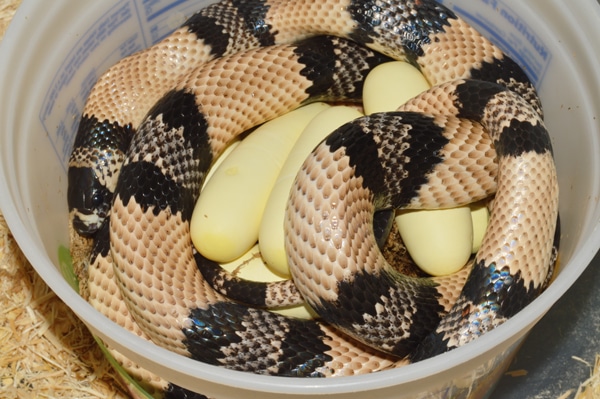Found throughout Central America and northwestern South America, Honduran milksnakes are large and powerful constrictors.
Although the year was 1978, I still vividly remember seeing my first Honduran milksnakes. I was a teenager working my first job in a reptile store in Colorado. During a visit to a local wholesaler, I was directed to a cage containing several specimens of Hondurans. Previously, the only milksnakes I had seen were the local Central Plains milks (Lampropeltis triangulum gentilis), which were small snakes that rarely exceeded 2 feet in length. These Honduran milksnakes were massive animals of 5 and 6 feet, and completely unlike any milksnake I had seen before.
Unfortunately, all were already sold and it would be many years before I would see Hondurans again. Then later, starting in 1991 and continuing through 2001, I began acquiring large numbers of snakes with the intent to expand into the full-time breeding business I own and operate to this day. And part of those acquisitions was a wide selection of hatchling Hondurans, including specimens of all the morphs that were available.
Natural History
The Honduran milksnake (L. t. hondurensis) is known to occur in forest floor and grassland habitat throughout subtropical lowland areas of Honduras, Nicaragua and extreme northern Costa Rica. One of several very similar milksnake subspecies found throughout Central America and northwestern South America, it is a large and powerful constrictor. While adults average 4 to 5 feet in length, specimens up to 7 feet in length are known.
Hondurans may be found from sea level to higher up into mountainous terrain, with specimens reported at elevations of up to 5,000 feet. There is usually little seasonal variation in climate this close to the equator.
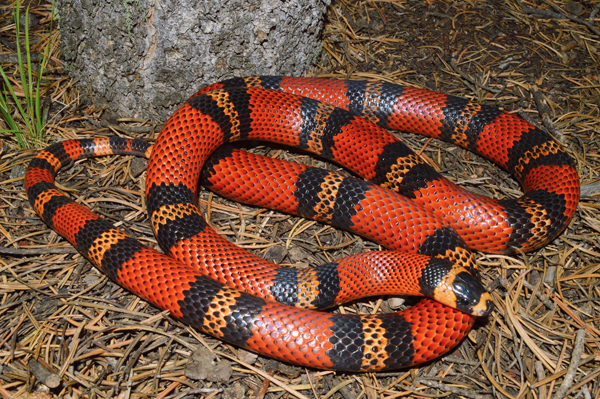
sean niland
There are two naturally occurring color varieties of Honduran milksnake: the tricolored and the tangerine (pictured).
The capital city of Tegucicalpa (3,261 feet above sea level) is at the western edge of the species’ range, and is representative of the upper altitude at which Honduran milksnakes are commonly found. Reported high/low (average) temperatures range from 80/55 degrees Fahrenheit (67) in winter months to 88/61 (75) in summer months.
Temperatures in the coastal city of Puerto Lempira, at the eastern edge of the Honduran’s range, are (42 feet above sea level) range from 83/71 (79) in winter months to 89/74 (84) in summer months.
Honduran Milksnake Handling Tips
Honduran milksnakes are well known for being difficult to handle and squirmy when young. Distressed specimens will often defecate in the hand, and if restrained may turn and bite. Luckily, this behavior quickly vanishes if they are handled regularly and is seldom seen at all in adults. It’s important to understand that it’s really a fear of being eaten that makes snakes act this way. After all, they live in a world filled with animals, including other milksnakes, that would love to make a meal of a young milksnake.
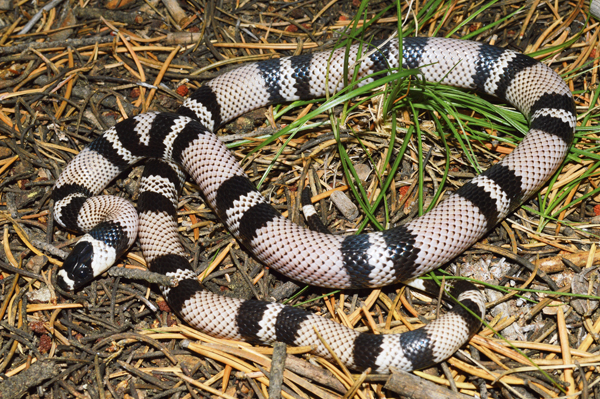
SEAN NILAND
Anerythristic Hondurans exhibit a near-total lack of red pigment.
The trick is to not try to restrain the snake, but rather allow it to move smoothly between your fingers, or from hand to hand. I often scoop them up out of the cage and cup them between two hands, allowing them to venture forth and explore my fingers as they calm down. Trying to simply grab up a young Honduran quickly by chasing it about the cage is sure to get the snake all worked up, and could result in a nip.
Honduran Milksnake Enclosure Tips
Honduran milksnakes are large and powerful, well designed for a life burrowing through leaf litter and loose soil. These characteristics also make them uniquely suited for escaping from cages, so regardless of the type of caging chosen, it must be absolutely secure! Like other members of the genus Lampropeltis, Hondurans are ophiophagus, meaning they will eat other snakes, including members of their own species. Therefore they should be maintained singly.
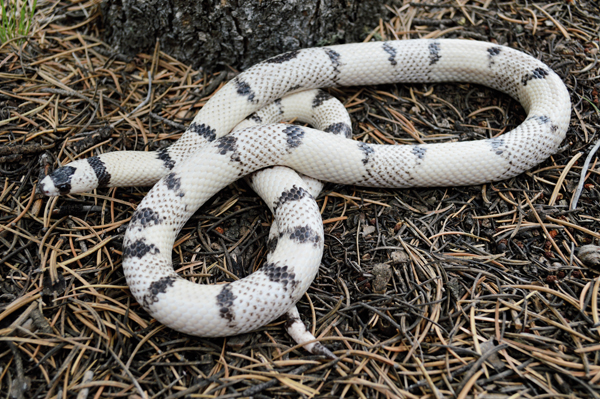
sean niland
This is a ghost Honduran.
They can be rather nervous (especially juveniles, as mentioned), and actually seem more comfortable in smaller cages than one would suspect. Compact hide houses are mandatory; use two, one at the warm end of the enclosure and one at the cooler end. This will allow the snake to choose its preferred temperature while still remaining hidden.
At VMS, we maintain our Hondurans in plastic tubs in a rack system, with 6-quart tubs 14½ inches long, 8 inches wide and 45/8 inches tall for babies, and 32-quart tubs measuring 23½ inches long by 16 inches wide by 63/8 inches tall for adults. Most hobbyists can utilize standard aquaria, and a 30-gallon aquarium (36 inches long by 12 inches wide by 14 inches tall) is appropriate for most adult Hondurans, and a 5 gallon (16 inches long by 8 inches wide by 8 inches tall) is plenty spacious for hatchlings and juveniles up to about 2 feet in length.
Undertank or substrate heating is recommended for a heat source. Place the heater at one end of the cage and use a thermostat to provide a warm side between 82 and 85 degrees Fahrenheit and a cool side between 72 and 75 degrees. Check these temperatures with a quality thermometer placed on the floor of the cage rather than a stick-on thermometer placed high up on a cage wall.
Normal ambient humidity is sufficient for Honduran milksnakes kept in most homes throughout the U.S. In drier climates, it may be necessary to increase humidity slightly. Signs this is needed include a snake’s failure to shed properly and/or excessive soaking in its water dish. If either are encountered, placing lightly moistened long-fibered sphagnum moss inside the hide houses is a simple cure. Replace the moss frequently, especially if it’s soiled.
A number of substrates have been used successfully with Hondurans. Paper towels or newspaper are easily changes and inexpensive, if unattractive. We have utilized shredded aspen bedding for decades; it’s inexpensive, lightweight and easily spot-cleaned. Some keepers prefer cypress mulch as it is natural looking and can be lightly sprayed to increase humidity. Unfortunately, it can be difficult to locate in many parts of the country. Do not use pine or cedar products for bedding.
Water should be provided in an easily cleaned dish placed on the cooler side of the cage. It is vital that you pay careful attention to its sanitation; a fouled water dish will quickly provide a source of infection for your snake.
Feeding Honduran Milksnakes
Feed young milksnakes an appropriately sized meal every five days and adults every seven days. Hondurans will feed on mice throughout their lives, beginning with large pinkies and ending with adult-sized mice. Simply choose the size of mouse having a body diameter equal to or very slightly larger than the girth of your snake at mid-body. Most Hondurans will accept frozen/thawed mice without hesitation. Do not handle the snake for a few days after feeding, as this could lead to regurgitation.
Captive Breeding
Although a practiced eye can visually determine sex, sexing adult and juvenile L. t. hondurensis is best done through probing. Hatchlings may be sexed through “popping,” which is the practice of manually forcing eversion of the hemipenes. Young milks are squirmy and have thick muscular tails, so a skilled hand is required to pop them successfully.
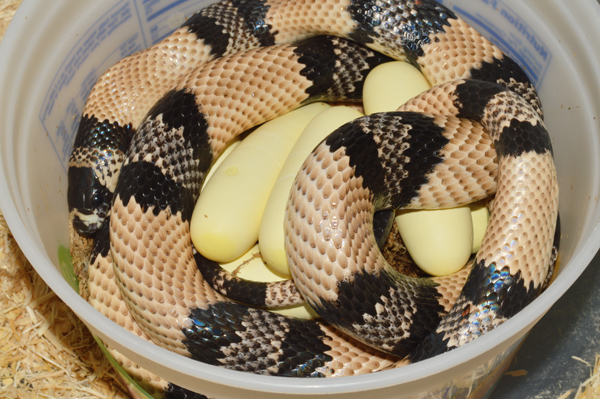
sean niland
An anerythristic Honduran female on a clutch of eggs.
Breeding begins with a winter brumation period of about three months. We darken the rooms, turn off belly heat and reduce temperatures to roughly 60 degrees throughout this time. Following brumation, temperatures are returned to normal and the snakes usually exhibit voracious feeding behavior.
Typically, females will ovulate and shed their skins after two to six weeks and should be placed with the males at this time. Copulation is usually immediate, and after a few matings the pair may be separated.
Females usually lay eggs six to 10 weeks later, and almost always complete a pre-lay shed cycle about 10 days before egg deposition. Provide a large tub filled with lightly dampened sphagnum moss as a laying site. We utilize half-gallon or larger plastic tubs with an access hole cut into the lid for this purpose. Do not place the tub on top of the cage heat source.
Clutch size ranges from four to 15 eggs, with most averaging eight to 10. Eggs are placed on moistened vermiculite (about three parts water to four parts vermiculite by weight) inside a sealed plastic box with a lid. This is then placed inside a simple incubator and maintained at 78 to 80 degrees until hatching. We do not puncture the box to provide air exchange, preferring instead to open it once a week for inspection. The boxes are clear and each incubator is inspected daily. Hatching takes place after 60 to 75 days.
Raising Neonate Milksnakes
Honduran milksnake hatchlings typically measure about 8 to 10 inches in length and raising them has proven to be incredibly simple. We place each in an individual plastic shoebox, and they are kept at the same temperatures as the adults. Shredded aspen is used as substrate, and a disposable water dish is provided. A flattened toilet paper tube makes a great disposable hide house. In drier climates, specimens may spend excessive amounts of time soaking in the water dish or even have difficulty in shedding. We remedy both problems by providing a disposable water dish containing very lightly dampened sphagnum moss.
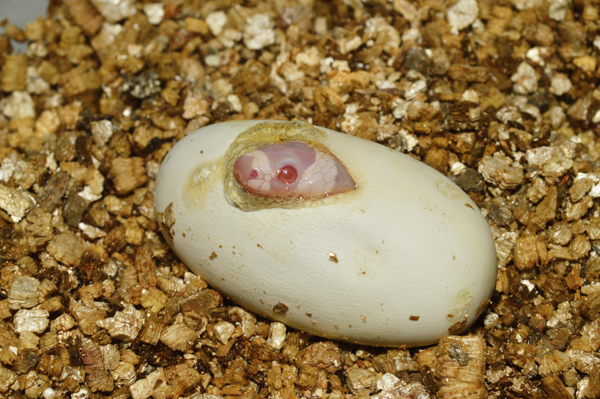
sean niland
A hatchling snow Honduran takes its first peek at the world.
Within a few days of hatching, neonates will shed their first skins, and soon after almost all begin feeding on large pinky mice. Most readily accept frozen/thawed pinkies, although a few will stubbornly hold out for fresh-killed or live prey. Babies are nervous little snakes, and care must be taken when offering meals so not to startle them.
Growth can be rapid if baby Hondurans are heavily fed, although recent studies indicate a slower growth rate and lighter feeding schedule promotes better long-term health. We limit our snakes to a single weekly meal of roughly the same body diameter as that of the snake. With this schedule, sexual maturity is achieved at 3 years of age, with strong reproduction for females in the fourth year.
Honduran Milksnake Morphs and Mutations
There are two naturally occurring color phases of the Honduran milksnake: tricolored and tangerine. Both are heavily banded, deep red snakes ringed with triads of wide black bands enclosing an off-white or yellow to deep orange band. Most specimens exhibit heavy black tipping on each scale, darkening the overall appearance. This natural variation makes for much variation in appearance of both naturally occurring colors and popular genetic mutations (morphs) common in captive collections.
Additionally, virtually all snakes currently in our hobby are not genetically pure L. t. hondurensis, which adds additional variation to the mix of appearances. Many founding specimens were imported years ago with inaccurate locality data and improper identification. Some were naturally occurring intergrades between adjacent subspecies. Milksnakes found in adjacent regions are very similar in appearance, and such unintentional stirring of the genetic pot created the incredible diversity of appearance seen in Hondurans today. A few genetically heritable mutations have also been found, and these have been combined with each other to create several “designer” morphs, as well.
Anerythristic. “Anery” for short, specimens have been collected in the wild on two known occasions. The first was imported in the early 1980s but failed to survive long enough to reproduce. A second specimen was imported in the late 1980s and wound up in the hands of Houston-area breeder David Doherty. Dave went on to breed the animal, ultimately producing the first captive-bred anerythristic Honduran in 1991. He proved the trait is inherited as a simple recessive.
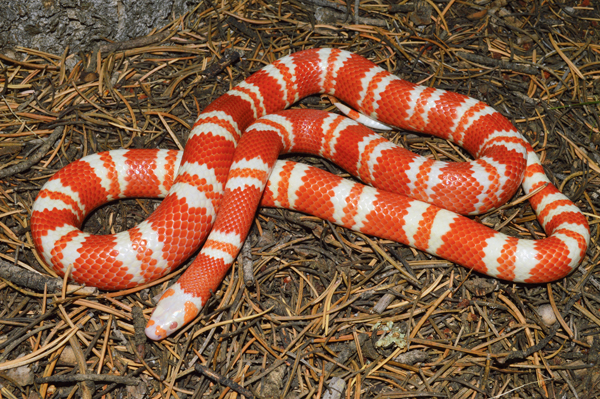
sean niland
Honduran milksnakes can be squirmy when young, but this behavior often disappears with regular handling. This is an albino tangerine Honduran.
Anerythristic Hondurans exhibit a near-total absence of red pigment. However, the subtle variations in underlying colorations of Hondurans still has an effect and subtle tones of pink, violet, yellow and even pale orange may influence the appearance. Thus, some would argue this mutation should be more properly called hypoerythristic, but the trade name anerythristic has already become firmly established.
Hypomelanistic. Hypomelanism (or “hypo”) is a unique mutation that causes a reduction in the amount of black pigmentation. There is no set amount of reduction, and some specimens can have very dark black rings while others may have very light gray or pale brown rings. The reduction in black affects not only the black banding, but the overall coloration of hypomelanistic snakes is lightened and brightened, with most appearing a lovely pumpkin orange in overall color.
Hypos in the trade trace their ancestry back to a single brightly colored imported specimen acquired by Florida breeders Bill and Kathy Love. The snake gave rise to a brightly colored line of tangerine Hondurans with equally wide bands trade named “Tangerine Dreams.” But breeding the original snake back to one of its own offspring yielded an amazing result: the first known hypomelanistic Honduran!
In the years since, breeders have refined various lines of hypos for specific looks. All are the product of selective breeding and quite variable in expression, often reproducing inconsistently. As with all selectively bred specimens, breeding two very good examples of the type usually leads to the greatest number of desirable offspring, but this is still far from a guarantee. Among these are bloodlines in which breeders have worked to lighten the black coloration into pale grays, and such lines as “extreme,” “ultra-light” and “mega” are all variants of this theme.
Amelanistic (albino). Amelanism first appeared unexpectedly in the collection of the Hortenbachs in Leipzig, Germany, in 1989. By the mid 1990s, they had produced a number of specimens and proven the trait is inherited as a simple recessive. At this point the group was sold to Louis Porras, who successfully brought the mutation to market in the U.S. beginning in the late 1990s. Around the same time, breeder Brian Barczyk also imported amelanistic Hondurans that later proved to be from the same bloodlines.
Amelanism causes the total loss of all melanin (dark pigments such as black or brown). The eyes are pink to light red in color. Amelanistic examples are powerfully influenced by the lighter yellow and orange pigments. While tricolored specimens are a clean, bright red with pink and white to pure yellow bands, tangerine specimens may exhibit white or yellow bands enhanced to such brilliant orange red that they appear to be bicolored orange red snakes with white bands. Many intermediate variations exist, as well. Many of the original albino Hondurans possessed very high band counts, and thus quite narrow rings. They have since been bred out to wider-banded Hondurans and much variation in band count can now be found in the marketplace.
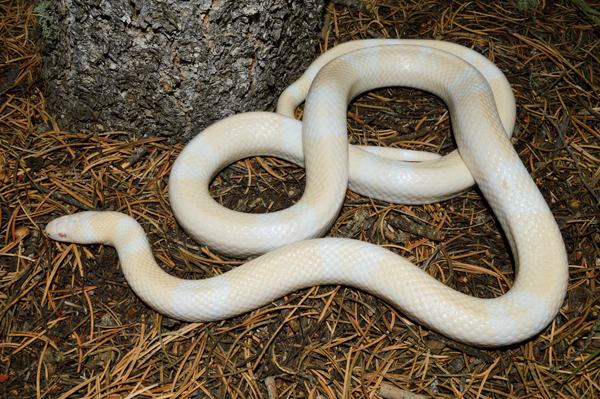
sean niland
With the beautiful variety of types available, there is a Honduran to suit just about every hobbyist’s taste. This is a snow Honduran.
Ghost. Combining hypomelanism with anerythrism into one double-homozygous snake was inevitable, and breeders produced the first ghost Hondurans in 1999. As expected, such snakes are a paler and lighter version of anerythristic. Just how much lighter and paler is quite variable, with specimens from tricolored lines being lighter and whiter than specimens from tangerine bloodlines. These may exhibit various amounts of pink, pale orange or even purplish coloration. The amount of black tipping present may vary, too, and the sheer number of possible variations makes the ghost Honduran a favorite of many keepers.
Snow. Like the ghost, this is another double-homozygous snake, this time combining amelanism with anerythrism. These snakes are lovely, indeed, with pale pink eyes and softly ringed with only faint traces of the original colors remaining. The exact coloration is quite variable, with specimens from tangerine lines exhibiting more coloration than those from tricolored lines. Many will gain pigmentations with growth, especially pale oranges and yellows.
Hybino. The third double-homozygous morph combines hypomelanism with amelanism. Because amelanism eliminates all traces of melanin, the melanin-reducing effect of hypomelanism has zero effect on appearance, and hybinos are visually indistinguishable from albinos. In fact, the only way to produce them with complete certainty is by breeding two hypos, both het for amelanism. Thus, any albino offspring produced are without doubt homozygous for hypomelanism.
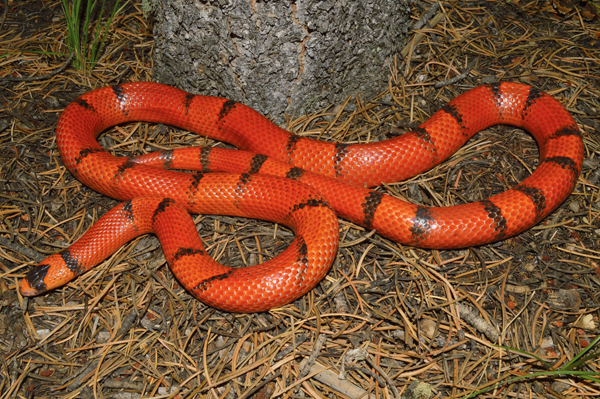
sean niland
Because Hondurans—this is a hypomelanistic specimen—will eat other snakes, including other Hondurans, it’s best to house them individually.
Pearl. A handful of triple homozygous for hypo, amel and anery Hondurans have been produced over the years. They are visually indistinguishable from snows and best produced by breeding specimens visually homozygous for hypo. At least one breeder has produced these from “extreme” line hypos, using the trade name “opal” to distinguish them.
Pin-Striped, Striped, Vanishing Pattern and Aberrant. Several pattern aberrancies are becoming established in the hobby. All appear to be line bred or polygenic in makeup, and none reproduce with the consistency of a simple recessive, such as albino. Some of these Hondurans are startlingly beautiful, and of course any or all can be combined with the various color morphs already established in the hobby.
Calico. I almost hesitate to mention this morph, but the snake in question was so remarkable and visually appealing that it deserves merit. In 2002, breeder Steve Michaels acquired what was labeled a “calico” along with several possible hets. Before the trait could be established, or even proven out for that matter, the snake tragically perished during a power failure. It was an unusually bright scarlet color, and every black pigmented area was filled with dense white speckling, resulting in a stunning look. Luckily, a number of photographs do exist, giving enthusiasts something to lust after and hope to see again one day.
Refinement of various selectively bred lines will continue and a resurgence of interest in locality-pure Hondurans is underway. As captive propagation of these beautiful snakes continues, new mutations are sure to appear and the development of additional color morphs should continue to add new dimensions of enjoyment to our hobby for many years to come.
Sean Niland is a full-time reptile breeder with nearly four decades of experience in reptile care and propagation. He owns and operates VMS Professional Herpetoculture, located in the mountains of southern Colorado. Visit VMS at vmsherp.com.

